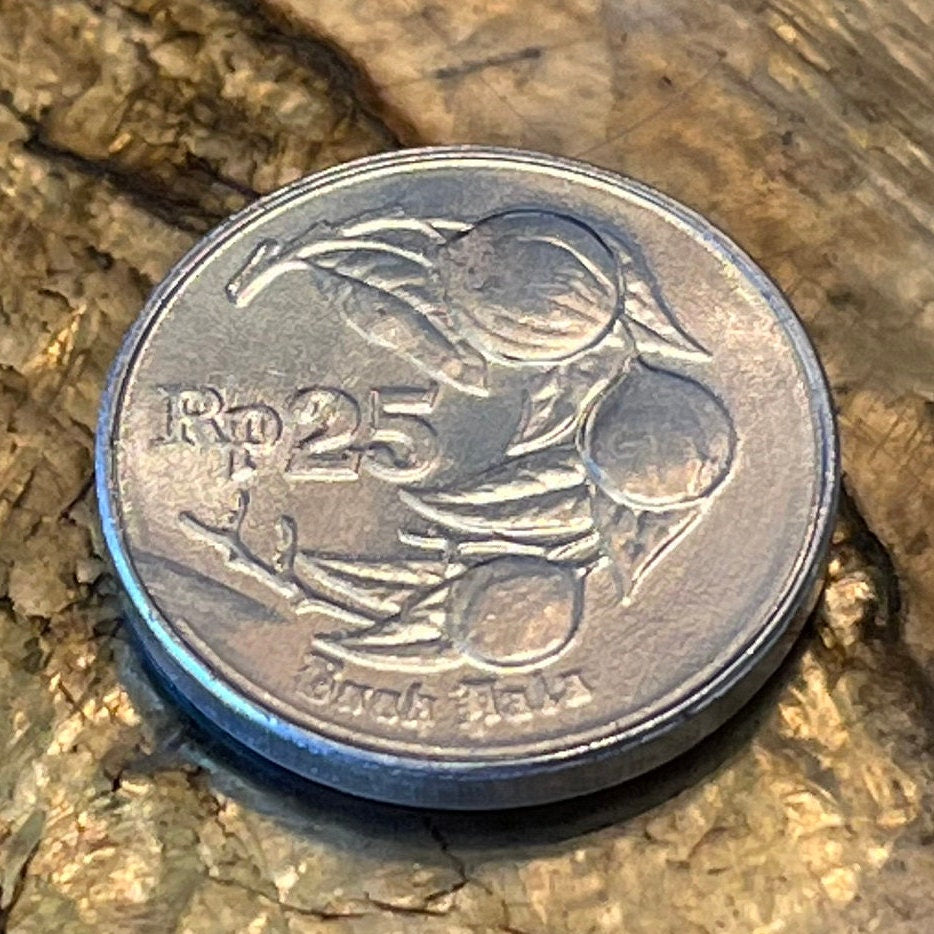elemintalshop
Nutmeg & Garuda 25 Rupiah Indonesia Authentic Coin Money for Jewelry and Craft Making
Nutmeg & Garuda 25 Rupiah Indonesia Authentic Coin Money for Jewelry and Craft Making
Couldn't load pickup availability
Nutmeg & Garuda 25 Rupiah Indonesia Authentic Coin Charm for Jewelry and Craft Making
Obverse: The National Emblem of Indonesia (Garuda Pancasila)
Lettering: BHINNEKA TUNGGAL IKA
BANK INDONESIA
Translation: Unity in diversity
Bank Indonesia
Reverse: Nutmeg (Myristica fragrans) with the denomination to the left
Lettering: Rp 25, Buah Pala
Translation: 25 Rupiah, Nutmeg
Features
Issuer Indonesia
Period Republic (1950-date)
Type Standard circulation coin
Years 1991-1996
Value 25 Rupiah (25 IDR)
Currency Rupiah (1965-date)
Composition Aluminium
Weight 1.22 g
Diameter 18 mm
Thickness 2 mm
Shape Round
Technique Milled
Orientation Medal alignment ↑↑
Demonetized Yes
Number N# 4525
References KM# 55, Schön# 42
Wikipedia:
Nutmeg is the seed or ground spice of several species of the genus Myristica. Myristica fragrans (fragrant nutmeg or true nutmeg) is a dark-leaved evergreen tree cultivated for two spices derived from its fruit: nutmeg, from its seed, and mace, from the seed covering. It is also a commercial source of an essential oil and nutmeg butter. The California nutmeg, Torreya californica, has a seed of similar appearance, but is not closely related to Myristica fragrans, and is not used as a spice. Indonesia is the main producer of nutmeg and mace.
If consumed in amounts exceeding its typical use as a spice, nutmeg powder may produce allergic reactions, cause contact dermatitis, or have psychoactive effects. Although used in traditional medicine for treating various disorders, nutmeg has no scientifically confirmed medicinal value.
The earliest evidence of nutmeg usage comes in the form of 3,500 year old potsherd residues from the island of Pulau Ai, one of the Banda Islands in eastern Indonesia. The Banda Islands consist of eleven small volcanic islands, and are part of the larger Maluku Islands group. These islands were the only source of nutmeg and mace production until the mid-19th century.
In the 6th century AD, nutmeg spread to India, then further west to Constantinople. By the 13th century, Arab traders had pinpointed the origin of nutmeg to the Indonesian islands, but kept this location a secret from European traders.
The Banda Islands became the scene of the earliest European ventures in Asia, in order to get a grip on the spice trade. In August 1511, Afonso de Albuquerque conquered Malacca, which at the time was the hub of Asian trade, on behalf of the king of Portugal. In November of the same year, after having secured Malacca and learning of Banda's location, Albuquerque sent an expedition of three ships led by his friend António de Abreu to find it. Malay pilots, either recruited or forcibly conscripted, guided them via Java, the Lesser Sundas, and Ambon to the Banda Islands, arriving in early 1512. The first Europeans to reach the Banda Islands, the expedition remained for about a month, buying and filling their ships with Banda's nutmeg and mace, and with cloves in which Banda had a thriving entrepôt trade. An early account of Banda is in Suma Oriental, a book written by the Portuguese apothecary Tomé Pires, based in Malacca from 1512 to 1515. Full control of this trade by the Portuguese was not possible, and they remained participants without a foothold in the islands.
In order to obtain a monopoly on the production and trade of nutmeg, the Dutch East India Company (VOC) waged a bloody battle with the Bandanese in 1621. Historian Willard Hanna estimated that before this struggle the islands were populated by approximately 15,000 people, and only 1,000 were left (the Bandanese were killed, starved while fleeing, exiled or sold as slaves). The Company constructed a comprehensive nutmeg plantation system on the islands during the 17th century.
As a result of the Dutch interregnum during the Napoleonic Wars, the British invaded and temporarily took control of the Banda Islands from the Dutch and transplanted nutmeg trees, complete with soil, to Sri Lanka, Penang, Bencoolen, and Singapore. From these locations they were transplanted to their other colonial holdings elsewhere, notably Zanzibar and Grenada. The national flag of Grenada, adopted in 1974, shows a stylised split-open nutmeg fruit. The Dutch retained control of the Spice Islands until World War II.
It has been suggested that Connecticut received its nickname ("the Nutmeg State", "Nutmegger") from the claim that some unscrupulous Connecticut traders would whittle "nutmeg" out of wood, creating a "wooden nutmeg", a term which later came to mean any type of fraud. This narrative may have to do with the issue that one has to grate to obtain the spice powder, not crack a nutmeg, and this may not have been widely known by some purchasers of the product.
***********
Wikipedia:
The front of the coin bears the national emblem of Indonesia (Garuda Pancasila) with the date of mintage above the issuer name below. Garuda (Sanskrit: गरुड Garuḍa; Pāli: गरुळ Garuḷa) is a legendary bird or bird-like creature in Hindu, Buddhist and Jain faith. He is variously the vehicle mount (vahana) of the Hindu god Vishnu, a dharma-protector and Astasena in Buddhism, and the Yaksha of the Jain Tirthankara Shantinatha.
Share










Really beautiful and very well packaged. Thank you so much.
5 stars review from Abby









